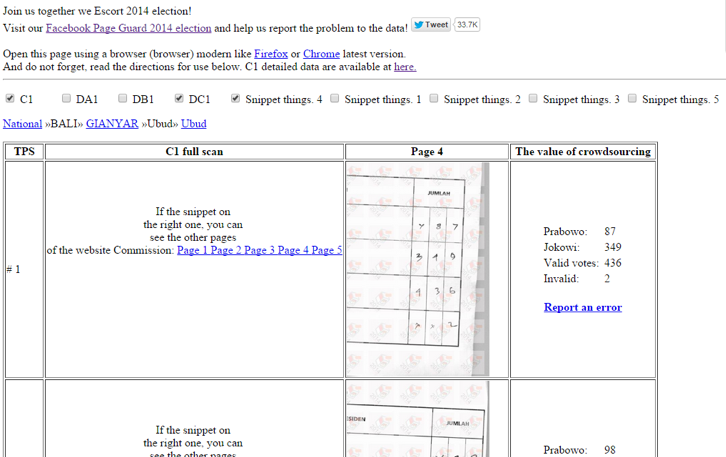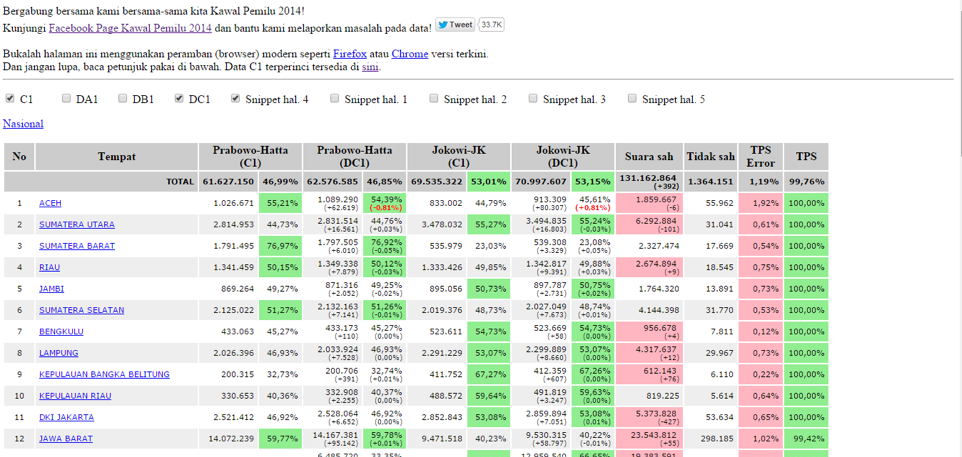The Global Impact of Open Data
Indonesia’s Kawal Pemilu
Elections: Free, Fair and Open Data
by Auralice Graft, Stefaan Verhulst and Andrew Young*
Reference
4 GovLab interview with Diah Setiawaty, Program Manager for Election Application Programming Interface, Perludem, September 10, 2015.
5 Brajawidagda, Uuf and Akemi Takeoka Chatfield. “Roles of Social Media in Open Data Environments: A Case Study of the 2014 Indonesian Presidential Election Voting Results.” 25th Australasian Conference on Information Systems. December 8-10, 2014. http://aut.researchgateway.ac.nz/bitstream/handle/10292/8170/acis20140_submission_176.pdf?sequence=1&isAllowed=y
6 GovLab interview with Diah Setiawaty, Program Manager for Election Application Programming Interface, Perludem, September 10, 2015.
7 “2014, Indonesia’s commitment to Open Data.” Open Government Indonesia. March 2, 2014. http://opengovindonesia.org/uncategorized-en/2014-indonesia-commitment-open-data/
8 Lukman, Enricko. “Indonesian voters are crowdsourcing ballot counts to protect against election fraud.” Tech in Asia. July 14, 2014. https://www.techinasia.com/kawal-suara-indonesia-voters-crowdsourcing-ballot-counts-protect-election-fraud/
9 “Top 10 Countries with most Facebook users 2014.” Addictive Lists. April 22, 2014. http://addictivelists.com/top-10-countries-with-most-facebook-users-2014/
10 Lipman, Victor. “The World’s Most Active Twitter City? You Won’t Guess It. Forbes. December 30, 2012. http://www.forbes.com/sites/victorlipman/2012/12/30/the-worlds-most-active-twitter-city-you-wont-guess-it/
11 GovLab interview with Diah Setiawaty, Program Manager for Election Application Programming Interface, Perludem, September 10, 2015. And Lukman, Enricko. “Indonesian voters are crowdsourcing ballot counts to protect against election fraud.” Tech in Asia. July 14, 2014. https://www.techinasia.com/kawal-suara-indonesia-voters-crowdsourcing-ballot-counts-protect-election-fraud/
12 GovLab interview with Ainun Najib, Co-Founder Kawal Pemilu, August 5, 2015.
13 Rakhmani, Inaya. “Technology for Transparency.” New Mandala. July 21, 2014. http://asiapacific.anu.edu.au/newmandala/2014/07/21/technology-for-transparency/
14 Bland, Ben. “Indonesian techies crowdsource election results.” Financial Times. July 18, 2014. http://www.ft.com/intl/cms/s/0/6c62a8b6-0e33-11e4-85ab-00144feabdc0.html#axzz3x2yImI1u.
15 Yusuf, Oik. “Siapakah “Pandawa” di Balik Kawal Pemilu?” Kompas.com. August 13, 2014. http://tekno.kompas.com/read/2014/08/13/09050057/Siapakah.Pandawa.di.Balik.Kawal.Pemilu.?utm_source=WP&utm_medium=box&utm_campaign=Khlwp. Translated into English by Google.
16 GovLab interview with Ainun Najib, Co-Founder Kawal Pemilu, August 5, 2015.
17 “The Five Pandawa Behind Kawal Pemilu.” Global Indonesian Voices. August 13, 2014. http://www.globalindonesianvoices.com/14988/the-five-pandawa-behind-kawal-pemilu/
18 Lukman, Enricko. “Indonesian voters are crowdsourcing ballot counts to protect against election fraud.” Tech in Asia. July 14, 2014. https://www.techinasia.com/kawal-suara-indonesia-voters-crowdsourcing-ballot-counts-protect-election-fraud/
19 Lukman, Enricko. “5 things you need to know about Indonesia’s election tech fighters.” Tech in Asia. July 18, 2014. https://www.techinasia.com/kawal-pemilu-indonesia-presidential-election-fighters/
21 Lukman, Enricko. “5 things you need to know about Indonesia’s election tech fighters.” Tech in Asia. July 18, 2014. https://www.techinasia.com/kawal-pemilu-indonesia-presidential-election-fighters/
22 After 460,000 forms, recruitment was stopped because Kawal Pemilu founders believed they had achieved their goals. In addition, the site had received considerable media coverage by this time, and the founders decided to stop recruiting because they feared that recruits might not be trustworthy anymore. GovLab interview with Diah Setiawaty, Program Manager for Election Application Programming Interface, Perludem, September 10, 2015.
23 GovLab interview with Uuf Brajawidagda, Lecturer of Indonesian Politics, University of Wollongong, Australia, September 3, 2015.
24 GovLab interview with Uuf Brajawidagda, Lecturer of Indonesian Politics, University of Wollongong, Australia, September 3, 2015.
25 GovLab interview with Uuf Brajawidagda, Lecturer of Indonesian Politics, University of Wollongong, Australia, September 3, 2015.
26 GovLab interview with Diah Setiawaty, Program Manager for Election Application Programming Interface, Perludem, September 10, 2015.
27 Lukman, Enricko. “As Indonesia’s democracy is on the verge of crisis, hackers and fakers attack crowdsourced vote counts.” Tech in Asia. July 18, 2014. https://www.techinasia.com/indonesia-democracy-crisis-hackers-fakers-attack/
28 Rakhmani, Inaya. “Technology for Transparency.” New Mandala. July 21, 2014. http://asiapacific.anu.edu.au/newmandala/2014/07/21/technology-for-transparency/
29 GovLab interview with Ainun Najib, Co-Founder Kawal Pemilu, August 5, 2015.
30 Rakhmani, Inaya. “Technology for Transparency.” New Mandala. July 21, 2014. http://asiapacific.anu.edu.au/newmandala/2014/07/21/technology-for-transparency/
31 “Lihat sendiri perbedaan APDB versi Pemprov dan DPRD di KawalAPBD.org.” Rappler. March 10, 2015. http://www.rappler.com/world/regions/asia-pacific/indonesia/86371-lihat-perbedaan-apbd-versi-pemprov-dan-dprd&prev=search. Translated by Google.
33 Rakhmani, Inaya. “Technology for Transparency.” New Mandala. July 21, 2014. http://asiapacific.anu.edu.au/newmandala/2014/07/21/technology-for-transparency/
34 Naing, Saw Yan. “Smartphone-Wielding Indonesians Tasked With Ensuring Fair Elections.” The Irrawaddy. April 7, 2014. http://www.irrawaddy.org/asia/smartphone-wielding-indonesians-tasked-ensuring-fair-elections.html
35 Ruslan, Heri. “Kawal Pilkada Publikasikan Real Count Pilkada Serentak.” Republika.co.id. December 20, 2015. http://nasional.republika.co.id/berita/nasional/pilkada/15/12/20/nzn40m372-kawal-pilkada-publikasikan-real-count-pilkada-serentak. Translated by Google.
36 GovLab interview with Diah Setiawaty, Program Manager for Election Application Programming Interface, Perludem, September 10, 2015.




